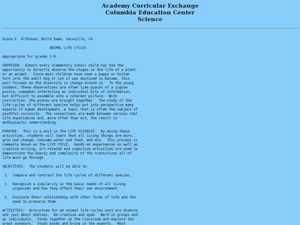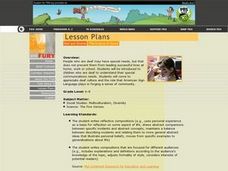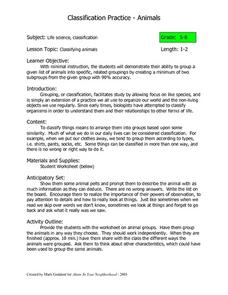Curated OER
Where Do Plants Get Their Food?
Young scholars think about the historical development of the scientific method. They design an experiment that replicates van Helmont's, using only specified materials. Pupils then improved upon van Helmont's procedure and also...
Curated OER
Earthquakes Study Guide
For this earthquakes worksheet, students answer questions about the components of earthquakes, the causes of earthquakes, how they are measured, the types of seismic waves and the types of faults. They also answer questions about the...
Curated OER
Animal Life Cycle
Students conduct hands-on experiments. In this life cycle instructional activity, students are able to observe a variety of animals as they travel through their life cycle (brine shrimp, mealworms, frog eggs and chicken eggs). Students...
Curated OER
Parachutes: What a Drag
Sixth graders make 2 different kinds of parachutes and record and graph the time for each one for the different drag forces. In this parachute lesson plan, 6th graders compare the results to the rest of the class of each parachute and...
Curated OER
Web of Predators and Prey
Students investigate the food chain by researching the Internet. In this ecosystem activity, students view the video "Competitor and Predator" and read a book from the series "The Magic School Bus." Students utilize a worksheet to...
Curated OER
Wood You Believe: Wood Products
For this wood products lesson, students walk to a forest near their school where they sit by themselves for a few minutes and quietly observe their surroundings. Students brainstorm wood or wood by products, discuss everything we get...
Curated OER
Plants and Animals
Students find common needs between plants and animals. In this plants and animals lesson students compare that both plants and animals need food and water. They also find the differences between plant and animal needs.
Curated OER
Introduction to Ocean Grazers
Students explore biology by creating a poster with classmates. In this oceanography lesson, students identify the importance of coral reefs to the ocean's ecology and examine a food web of ocean animals. Students define a list of...
Curated OER
Ocean Grazers: Class Field Trip
Students explore biology by participating in a field trip. In this oceanography lesson, students define the survival characteristics of bottom dwelling creatures also known as ocean grazers. Students attend a class field trip to a beach...
Curated OER
Growth Stages 1: Infancy and Early Childhood
Students explore biology by completing a human growth worksheet. In this child development lesson plan, students read assigned text about the human birth process and the ideal growth patterns for a child. Students answer study questions...
Curated OER
On the Attack
Students explore how government restrictions and over fishing impact the ecosystems of sharks and contribute to or curb their danger to humans. They synthesize their understanding of the issues by creating board games in groups.
Curated OER
Creature Feature
Students work in pairs to create a creature and its habitat out of construction paper. Then students write a narrative to describe the animal and its habitat.
Curated OER
Physics Park
Students research and design a playground for a park or school in their community. They explore the physics concepts that are present in the design and, if applicable promote their ideas to city or school officials.
Institute of Electrical and Electronics Engineers
Critical Load
Students analyze critical load and how to reinforce the design of a structure to hold more weight. They examine basic structures and which materials to select. They create a prototype to hold more and more weight.
Curated OER
Navigating Change
Students participate in different activities to discover how they relate to the environment. They watch a video series and answer comprehension questions. They discuss what they can do to protect the environment.
Curated OER
Deaf and Diverse
Students examine deaf culture and the role that American Sign Language plays in forging a sense of community.
Curated OER
Have a Heart!
Students assume the role of a doctor, detective, and decision maker. They research the function of the heart, the diseases associated with the heart, and lifestyle choices that are heart healthy. Information gathered will be placed in a ...
Curated OER
A House for Me- Ocean Environments
Learners explore ocean environments. For this ocean environment lesson, students identify the things ocean animals need for survival. Learners use KWL charts and search the Internet collecting information about ocean habitats. Students...
Curated OER
Classification Practice-Animals
Students use pictures of animals to make a classification system. In this classification lesson plan, students are given pictures of different animals. They create a classification system for the animals and identify what they have in...
Curated OER
The Parts of a Perfect Flower
Young scholars explore the parts of a flower. In this flower structures lesson plan, students study a model of a flower and dissect a flower. They label each structure of the flower and observe the pollen grains and ovules under the...
Curated OER
Energy Changes, Rates of Reactions, Nuclear Chemistry
In this energy changes, rates of reactions and nuclear chemistry learning exercise, students solve 14 problems to review concepts about endothermic and exothermic reactions, heat of combustion, heat of reactions, enthalpy, kinetic and...
Curated OER
The Periodic Table of the Elements
Young scholars research the elements used to create fireworks. In this periodic table lesson, students discuss common metals, their characteristics, and their places on the periodic table. They work in small groups to research the...
Curated OER
What is it...A Frog or a Toad?
Students write a story. In this frogs and toads comparison lesson, students read facts comparing frogs and toads, use a t-chart to record factual information and complete a Venn Diagram. Students complete a four square writing template...
Curated OER
Topo Map Mania!
Students read and use topographical maps. They also use a compass to find bearing to an object on a map and in the classroom. Ask your students how they might travel to somewhere they have never been to befo

























